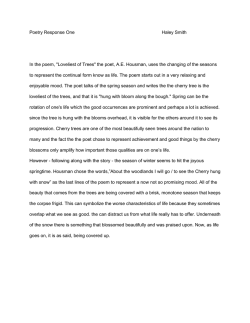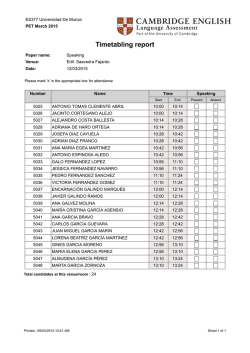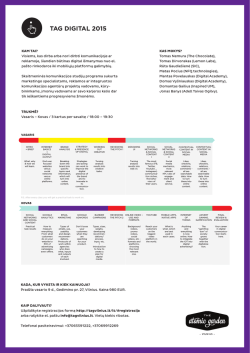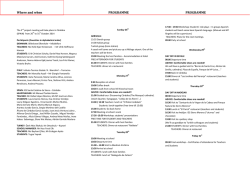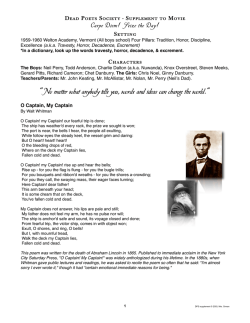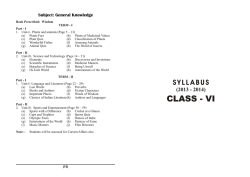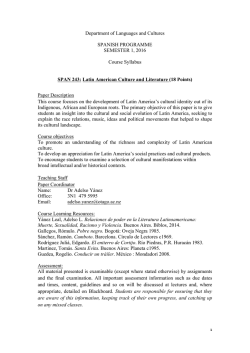
“Tomas para un Documental” (“Shots for a
Liminalities: A Journal of Performance Studies Vol. 11, No. 3 (August 2015) “Tomas para un Documental” (“Shots for a Documentary”) and the Thick Framing of History Constanza Ceresa “Dock Sud_01,” by Félix Rodríguez (2004). Used by permission of the artist. The Riachuelo industrial zone in the outer port area of Buenos Aires looks like a landscape corroded by the effects of idle time. Daniel García Helder’s poem “Tomas para un documental” maps the material and rhetorical remnants of a declining political imaginary provoked by a neoliberal economy forcefully imposed during Carlos Menem’s administration at the beginning of the 1990s. By standing in a temporal interstice in which past, present, and future merge, a situated body tries to awaken and liberate the circulating affects of the territory, calling for collective commemoration of an historical process. Constanza Ceresa (PhD, Latin American Cultural Studies, Birkbeck College, University of London) is a postdoctoral research fellow at the Centre of Latin American Cultural Studies, Universidad de Chile. Her research focuses on the relationship between poetics and politics in contemporary Chilean and Argentine poetry and film. Her postdoctoral project discusses the new realisms in current literary and cinematic works in both countries. ISSN: 1557-2935 <http://liminalities.net/11-3/tomas.pdf> Constanza Ceresa Thick Framing of History 1. Once an incarnation of national populism’s prosperous utopia, the industrial zone of Riachuelo in the outer port area of Buenos Aires now appears as a landscape corroded by the effects of unproductive time. This desolate image conveys the social, economic, and political devaluation provoked by a neoliberal economy forcefully imposed during Menem’s administration at the beginning of the 1990s. Daniel García Helder’s “Tomas para un documental” makes visible the marks this structural violence has left by travelling through the desolate landscapes of industrial cemeteries. In this study I aim to explore how the documentary approach adopted in this poetic work offers a particular experience of time and space that permits both a consideration of framing/naming possibilities after a moment of destruction and a mapping of the place’s affective force. Born in Rosario in 1961, Daniel García Helder’s works, including El faro de Guereño (1990), El guadal (1994) y La vivienda del trabajador (2008), stand at the historical crossroads of the end of the dictatorship and the transition to democracy. The experience of this inbetweenness is transposed into poetic form in his unpublished work “Tomas para un documental,” written between 1992 and 1995. Fragments of the work can be found in different literary magazines such as Punto de Vista (Buenos Aires, 1997), La modificación (Madrid, 1998), and Matadero 103 (Santiago de Chile, 2002), as well as in some contemporary anthologies. His poetry emerged during a period of significant transformation in post-dictatorial Argentina. According to Idelver Avelar, during the transition period to democracy (1983-1989), president Raúl Alfonsín’s systematic concessions to the military concerning crimes committed during the dictatorship (1976-1983), as well as to the IMF concerning issues of economic policy, produced a sentiment of disenchantment in the Argentine population (60). Carlos Menem’s ascent to power along with his “neoliberal kitsch version of Peronism” at the beginning of the 1990s (61) brought about the deregulation of the Argentine economy and an escalating process of trans-nationalisation that expanded and consolidated large economic groups and undermined the weakest fractions of mid-range and small business capital. In order to open the national market to foreign investors and increase imports, the country underwent a coordinated process of “de-industrialization” of local production and the privatization of public industries. With the expulsion of the labour force from the industrial sector to the tertiary sector together with the move towards selfemployment that was seen during the dictatorship, the core of the nationalpopular model of national industrialization and its motto “Freedom or 2 Constanza Ceresa Thick Framing of History Dependence” was thrown into crisis. 1 In Maristella Svampa’s view: “The country attended to the structural crisis of the national-popular model, without discovering the formula, both economic and political, that would regain the lost key to social integration” (23-25).2 Menem’s economic project gave shape to a new social order in which “the free market replaced almost naturally the organized community and the welfare state” (Novaro 234). Likewise, the corroded ethical bases of democracy after such economic measures and the application of amnesty laws provoked a “decollectivization of vast sectors of society” and consequently “an entry into a period of individualisation of the social” (Svampa 47). Rapid changes in production modes also had an important impact on the literary production of the period. The poets emerging at the end of the 1980s and beginning of the 90s had to reassess the role of literature in the present. In 1986, the first edition of the literary journal Diario de Poesía was published in Buenos Aires, becoming the main platform for new objectivist poetry emerging in Argentina at the time.3 Diario de Poesía assumed the task of circulating and translating works from the modernist movement of objectivist poetry such as that of Ezra Pound, William Carlos Williams, Louis Zukofsky, George Oppen, Charles Reznikoff, and Carlo Rakosi, among others. Locally, it also republished the work of Argentinian poets such as Alejandra Pizarnik, Arturo Carrera, and Juan L. Ortiz, as well as Juan José Saer’s novels and poems. For many emerging poets, Diario de Poesía carried out the double task of offering an alternative to neobaroque lyricism and of providing a creative platform for sharing their poetic work. At the beginning of the 1980s, a neobaroque style had become an alternative emancipatory type of writing to the earlier heterosexual rationalist style characteristic of the politically committed Latin American poetry of the 1960s. By the mid-1980s, the less tropical and more eschatological version of neobaroque, coined by Néstor Perlongher as “neobarroso,” in which the golden forms of the baroque were covered with Río de la Plata mud, became a leading tendency in Argentina after the 1984 publication of his delirious political poem “Cadáveres.” In 1987 Daniel García Helder published the article “El neobarroco en la Argentina” in Diario de Poesía, thus establishing a poetic basis for the so-called “poetry of the 90s.” By giving a thorough and unenthusiastic 1 Perón understood industry to be the engine that ran economic development in Argentina. His economic and social project of industrialization began in the early 1940s, when he nationalized all foreign-owned railways in Argentina (70 per cent Britishowned) as well as foreign telephone companies, among others. 2 Apart from the fragments of “Tomas” gently translated by Dr. Valentino Gianuzzi, all translations from Spanish to English are mine. 3 Diario de poesía was directed by Daniel Samoilovich. During this period, the editorial committee included García Helder, Daniel Freidemberg, Diana Bellessi, Jorge Fondebrider, and Martín Prieto, among others. 3 Constanza Ceresa Thick Framing of History account of neobaroque’s literary origins and its specific verbal operations (classified in terms of surface, cosmetic/parody, and self-absorption), he intended to prove that this literary tendency had lost its once characteristic power to disturb.4 In contrast to a poetics of excess in which “words enter a state of opacity, they refer to each other and are not subject to a communicative purpose” (24), García Helder called for an economy of language based on concision and precision, drawing on Ezra Pound’s maxim “great literature is simply language charged with meaning to the utmost possible degree.” In his study of the poetic generation of the 1990s, Edgardo Dobry situates this objectivist poetics within a new social imaginary where political discourses have lost their consistency: Algo del imaginario social argentino, marcado por un radical desengaño de todas las promesas políticas, institucionales, ideológicas, se plasma allí. No tiene que ver con la posesión de mayor o menor número de lecturas, sino con la adhesión a una estética de lo bajo, de la violencia cotidiana, del rechazo de toda institución política que se atribuya el poder de establecer escalafones de sublimidad poética. (133) Something of Argentine social imaginary, marked by a radical disappointment in all ideological, institutional, political promises, is expressed there. It has nothing to do with the possession of a greater or lesser number of interpretations, but with the adherence to an aesthetic of low, everyday violence, the rejection of any political institution that grants itself the power to establish rosters of poetic sublimity. According to Dobry, in the urgent search for a more direct registration of the present, visual mediation gains a pivotal place in these poetic works, transforming the poet into a cameraman who films reality in its chaotic character “with the same screeching with which it manifests itself” (271-2), that is, without embellishing what is in front of his eyes. A similar idea is found in García Helder’s poem “Sobre la corrupción” (“On corruption”), included in the collection El faro de Guereño (1990), which reflects on the role of the poet within new modes of production: Puede que cada forma sea un gesto, una cifra, y que en las piedras se oiga perdurabilidad, fugacidad en los insectos y la rosa; … sé que ahora, al menos, no me conviene interpretar mensajes en nada, ni descifrar lo que en las rachas 4 In this text García Helder tracks the origins of neobaroque to a literary group inspired by José Lezama Lima’s poetry, which published in the magazine Orígenes, edited by the Cuban writer Severo Sarduy. With regard to the Argentinian version, he refers to the poets included in the two anthologies made by XUL magazine, mainly followers of Néstor Perlongher, and the “neorromantic” publishing house Último Reino. 4 Constanza Ceresa Thick Framing of History del aire viene y no perdura (la imagen nítida, pestilente, de los sábalos exangües sobre los mostradores de venta, en la costa). (43) Each form may be a gesture, a figure and sound of durability on the stones, transience in the insect and the rose; ... I know that now, at least, it does not suit me to interpret messages in anything nor figure out what in the gusts of air comes and does not last (the sharp, stinking image of bloodless shad on sales counters on the coast). The poem establishes a negative dialogue with the poem “Coloquio de los Centauros,” found in the Spanish-American modernist poet Ruben Darío’s Prosas profanas, and his symbolist interpretation of reality (Porrúa, “Poéticas de la mirada”). In contrast to Darío’s poetry, this materialist depiction cancels the essentials of lyricism—namely, embellished symbolic language and the figure of the lyrical subject as inner life. Rather than a symbol of something or a source of mystery (rose, stone), nature is depicted and perceived as the field where relations of production take place in the present. The poem not only comments on the pervasive character of the economic system in which poetry cannot have an outside position (the clear and stinking image of commodities [fish] being traded on the coast), but also on a change of attitude towards the representation of its immediate physical environment. The transience of the material world in industrial cemeteries becomes an enquiry into the logic of historical discourse in “Tomas para un documental.” As Marc Augé proposes, “to watch ruins is not to make a journey to history, but to live the experience of time, of pure time” (45), and this particular experience of time is brought about by the continuous present of documentary mediation in García Helder’s poems. First, we find an impersonal observer registering a concrete and non-idealised reality before his eyes. Second, the narrative and descriptive character of the poems emphasises the alleged transparency of language, that is, its predominantly referential function. However, such experience of pure duration also enables what is circulating between the eye and what is registered to take form. In other words, the documentary approach functions as a sensory device that captures the affective force of the territory, giving shape to what Idelber Avelar calls a “topology of affects.” For Avelar, affects “are not exhausted within the boundaries of ego psychology or any other narratives grounded on the primacy of interiority and the self.” On the contrary, they are immanent to the social field (22). In the same line, Jonathan Flatley calls this operation “affective mapping.” For Flatley, unlike the inner dimension of emotions, affects indicate something relational, transformative and intentional, that is, they are always experienced in relation to an object or objects, establishing a “somewhat fluid relationship” between subject and object (25). In his view, it is not just ideologies or cognitive maps that shape our behaviour and practices in the world, but also the affects brought about by the relevant social structures of our world. In Benjamin’s terms that sensory feeling 5 Constanza Ceresa Thick Framing of History (Empfindung) “is not experienced in the brain, but in the materiality of the place” (Illuminations 27). The role of an aesthetic work would be to map and give a mobile form to those flows, producing a sense of defamiliarization in the reader, making “one’s emotional life appear unusual, and thus capable of a new kind of recognition, interest, and analysis” (80). Withdrawing the referential function and the figure of the subject as inner life, the documentary mediation is transformed into a sensory device that invites the reader to focus on what exceeds representation. With this in mind, “Tomas para un documental” can be read as a poetic cartography that reconstructs a social landscape by mapping the affective force and transposing it into poetic materiality. By standing in a temporal interstice in which past, present, and future merge, a sensory body tries to awaken and liberate the circulating affects of history. A close analysis of two poems published in Punto de Vista (1997), along with their accompanying expressionist engravings by Argentine artist Félix Rodríguez, will help elucidate how the force that exceeds representation is articulated at the level of both the image and prosody in the field of the poem. “Puente Alsina,” by Félix Rodríguez (2004). Used by permission of the artist. 6 Constanza Ceresa Thick Framing of History 2. II. Un haz rielando en las aguas negras del antepuerto y entre explosiones de motor un par de remolcadores van haciendo girar ciento ochenta grados al Barbican Spirit, de bandera filipina, entre cuyos mástiles negros se hamaca la estela luminosa del año que pasó, número mil novecientos noventa y uno A light-beam shimmering in the outer harbour sewage and among motor bursts a couple of tugboats are turning the Barbican Spirit one hundred eighty degrees; its flag Philippine, its black masts hammocking the luminous wake of the past year, number one thousand nine hundred and ninety one los ojos de una piba en el umbral del New Seúl Electrojuegos el blanco amarillo de sus ojos por debajo de unos iris glaucos ponientes gotas que permanecieran en la rama sin secarse para caer con diferencia de segundos, clip clop, sobre una pila de diarios the eyes of a chick on the threshold of New Seoul Electrogames the yellowish white of her eyes beneath setting glaucous irises droplets which remained in the branch without drying and fell within seconds of each other, clip clop, on a pile of newspapers Barcos fondeados, barcos de poco calado y más barcos semihundidos, la chatarra flotante como ejemplo de negatividad, un NO rotundo, vestigios de una vida consumida y que no fue enterrada como ese almacén EL TRIUNFO, los muros de ladrillo colorado entre la vuelta de Berisso y la de Badaracco Moored boats, shallow draft boats and more boats half-sunken, floating junk as an example of negativity, a resounding NO, shipwreck of a life spent which was not buried as that store TRIUMPH, red brick walls between the bends of Berisso and Badaracco donde el cielo se pone del mismo color de la arena vítrea que ahí se amontona, o como esa otra ferretería vieja de Barracas cuyo nombre en la chapa oxidada lleva un buen rato descifrar pero al final emerge, casi un recuerdo: DEL PORVENIR 7 Constanza Ceresa Thick Framing of History where the sky turns the same colour as the glassy sand which piles up there, or like that other old hardware store from Barracas whose name in rusty tin takes a while to decipher but eventually emerges, almost a memory: OF THE FUTURE VI Vi los barcos podridos las quillas de esos barcos también podridas las gomas los tarros maderas corchos bidones todo lo que flota por naturaleza o con ayuda del aire que contuviera en su interior flotando en el agua bofe en la pura inconciencia con visos de aceite quemado I saw the rotten boats the keels of these ships also rotten the gums the jars woods drums corks everything that floats naturally or with the help of air contained within it floating in the water lungs in sheer unconsciousness with sheens of burnt oil 2 esculturas sobre una misma cornisa en ruinas y lonjas de nubes color salmón fletadas desde el Partido de Lanús por un viento soplador: mutiladas, los fierros del esqueleto emergían de cuellos y muñones: el yunque del trabajo en ensamble con la rueda del progreso, dentada/ 2 sculptures on the same ledge in ruins and sliced salmon clouds chartered from Partido Lanús by a blowing wind: mutilated, skeleton irons emerging from necks and stumps: the anvil of work in assembly with the wheel of progress, toothed/ … Grúas Osgood, Bueyrus, norvest, menck, etc todos afiches de la lista verde en grandes letras COMPAÑEROS GÜINCHEROS Y MAQUINISTAS DE GRÚAS MÓVILES SIGAN CON LA VERDE POR UN SINDICATO CON IDEAS REALISTAS Osgood Cranes, Bueyrus, NorVest, Menck, etc. posters of the green list in large letters FELLOW WINCH AND MOBILE CRANE OPERATORS VOTE GREEN FOR A UNION WITH REALISTIC IDEAS 8 Constanza Ceresa Thick Framing of History Y vi ese otro que dice PELIGRO CABLES 25.000 VOLTIOS en el puente del Ferrocarril Roca manufactured by Francis Norton & C Ltd, de Liverpool, consulting engineers Liversey Son & Henderson, de Londres, desde donde vi (leí) NOICUTITSNOC sobre el edificio de la estación And I saw that other one saying DANGER 25,000 VOLT CABLES at the Roca Railroad Bridge manufactured by Francis Norton & Co. Ltd of Liverpool, consulting engineers Liversey Son & Henderson, London, where I saw (read) NOICUTITSNOC on the station building (García Helder, “Tomas” 2-4) According to Walter Benjamin, technology becomes significant only after the temporal discourse used to shape the material world has decayed. As these decaying structures no longer have authority over the collective imagination, it is possible to recognize them as the illusory dream images they always were, but whose aura has disintegrated (Buck-Morss 170). The floating junk—boats, vestiges of shop advertisements, political signs, and random objects—emerges like traces of a technological and rhetorical edifice that has fallen apart. Every object in space and each word within the poem condense an affective history, once and still invested with hopes and dreams. For Adrián Gorelik, the obsolete technology of this post-industrial territory is still inhabited by active icons of the imaginary of progress that praised technical rationality and its promises about the future (Gorelick 152). Remnants appear as evidence of this truncated future in verses like “shipwreck of a life spent which was not buried as that store TRIUMPH” and “like that old hardware store from Barracas whose name / in rusty tin takes a while to decipher / but eventually emerges, almost a memory: THE FUTURE.” García Helder’s verses/shots focus on material particularities without trying to compose an overall narrative. Without the symbolic investment of national popular discourse that used to provide meaning and value to that urban landscape, objects are not distributed rationally but affectively. The poem expresses an experience of pure duration through its prosody and its image construction. Prosody corresponds to the acoustic and rhythmic effects of the poem, that is, to the temporal disposition of words in the space of the poem. In this way, through the very act of reading, the senses are exposed to interconnected affective forces and new meanings can be achieved. At the level of image, the poem as “camera” covers the surface of the waters registering colours, textures, smells, and noises. In the first stanza, images flash in the dark in brief instants of time creating the poem’s “chiaroscuro” effect, as in “a light-beam shimmering in the outer harbour sewage”—and in the luminous wake of the boat swinging between black masts carrying the passing year nineteen ninety one. The same “chiaroscuro” effect is evident in the Rodríguez engravings accompanying the printed text. Here thick-textured black and white 9 Constanza Ceresa Thick Framing of History lines fill space. The contradiction between the luminous movement of the water and the opaque materiality of death condensed by the sluggish force of stagnant water evokes Benjamin’s idea that “the past can be seized only as an image which flashes up at the instant when it can be recognized and is never seen again” (Illuminations 247). It makes manifest the antagonistic forces mapped by this poem, forces that cannot be symbolized, but only perceived as sparks of meaning or as a repulsive image that bursts forth from the poem. Rather than provide us with a sense of location, objects floating on the liquid of an animal lung or “in sheer unconsciousness with sheens of burnt oil” introduce an ambiguous space. If this is in fact an unconscious space, then these abject images can be perceived like the embodiment of a deadly force that lurks beneath any logical narrative of history. This is why in the first fragment the floating scrap emerges as an example of negativity, “a resounding NO.” It is this excess that resists being absorbed by symbolic containment. The poem also exhibits cinematic procedures, particularly in the way images are framed and assembled. A shot is “the basic building block of all films, which normally consist of a series of shots edited together.” It is characterized by the apparent distance between the camera and the subject, the angle of the camera, the camera movement, and by the content or number of characters (Kuhn and Westwell). The camera movement in the poem indicates a physical presence in a manner similar to a cinematic travelling shot. The first stanza presents a panoramic point of view of the outer port while the second shifts to a close-up of the girl’s eyes, followed by the detail of an uncertain image of drops falling. Indeed, the verse “droplets which remained in the branch without drying” generates a vague meaning that fluctuates between a metaphorical image (the drops are actually the girl’s tears) and the juxtaposition of the image of a drop in an actual tree branch with the girl’s eyes. Later the camera zooms out, framing a wider shot of the colour of the sky and, later, zooms in to the rusty tin of the hardware store trying to decipher “the future.” Thus, in “Tomas,” the construction of the shot (i.e., the camera movement of the eye, the zoom in or the zoom out) reinforces the act of visually scanning what has been registered, and, in this way, dirtying the alleged transparency of language. The poem’s moving eye certainly contrasts with Rodríguez’s wood-block engravings. Its very technique suggests an anchoring with the medium, a weightiness that in cinematic terms would be closer to the fixed shot than to the travelling movement of the camera. However, while the stillness of the engravings creates an effect of pure time in the viewer, calling the attention to its materiality, in “Tomas” this effect is not produced visually, but through its syntactic construction and rhythm. The poem’s prosody reinforces time inside the image just as long shots do in films. This effect of “pure duration” is produced by the insistent use of present participles such as “shimmering,” “are turning,” and the onomatopoeic sound image of drops falling—“clip, clop.” With 10 Constanza Ceresa Thick Framing of History regard to the poem’s metric configuration, each stanza consists of five verses forming a quintet. There are verses/shots overlapping each other through arbitrary line breaks, as in the two last verses of the first stanza of the first poem, where the adjective (luminous) is detached from its noun (wake), thus bending the verse. In the second poem above, the sentence “I saw” (vi) is repeated at the beginning of the fourth quintet as well as attached to the conjunction “and” (y), where the repetition opens an extended series of enumerations (Porrúa 92). The relation between the preterit verb “I saw” and the slow but rhythmic description of the shot creates a temporal displacement within the poem. “I saw” refers to an action already completed by a first person in the past. Yet, the verse remains open throughout the stanza as part of the same long shot; a continuous present reinforced by the syntactical dislocation that displaces the verb “vi.” The same is true of the words “also” and “rotten,” where it is not clear if the adjective corresponds to “the keels” or to “the gums” and if it actually affects the “jars wood drums corks.” This is again the case with adjective “mutilated” that corresponds to the noun “clouds” but also supports a powerful meaning as a pure sound image. Such syntactic indiscernibility generates an internal paradox in the poem, between the visible regular “metric” (the quintets) and a force that exceeds its form, which is well expressed in the unstable boundaries of its cinematographic/ poetic grammar. The self-reflexive remark in the poem emphasises that representation is an arbitrary act of selection in time. On the one hand, it affirms “I saw,” on the other hand it simultaneously refers to an absence, to what was left out, that is, to what the eye did not see. This play between presence/absence in the text can be related not only to the effects of chiaroscuro in Rodriguez’s prints, but also to the process of making an engraving itself, which entails sculpting a block of wood and then applying ink to it.5 The initial image sculptured is the negative of the image printed. The surface that bears the ink appears dark—it is the white areas that have been carved out. Both the poem and engravings appear as representations in reverse by carving out and discarding wood to make empty spaces and, thus, bringing the affective force that resists symbolization to the fore. Both evoke Argentina’s economic situation through a history of its discarded materiality. Although “Tomas” conveys a narrative in that it describes what is seen, the narrative is that of a drifting body guided by the senses. Gradually, objects acquire more autonomy from the description and particularities start to reveal a singular temporality that resists being subordinated to a higher level of significance. Consequently, predicates cannot form a progression. In this way, the wheel of progress with the “anvil of work”—an emblem of labour or work in many administrative areas—relates horizontally, that is, without hierarchy to the 5 I thank Sophie Halart for this nice observation. 11 Constanza Ceresa Thick Framing of History rest of the decomposed materiality, becoming a ruin among ruins. In this continuous present of always-incomplete perception, objects are described with an excess of modality or explanation by the use of periphrasis, as in the case of “everything that floats naturally or with the help of air / contained within it floating in the water lungs.” This redundant structure has a specific durational effect: he saw “everything that floats floating.” The adjective of this long and dislocated sentence only appears with the participle “flotando” which affects retrospectively the long list of objects just named. Although the whole stanza could be summarized as “I saw objects floating in the water,” much more is being conveyed by its syntactic twisting. This particular present can only make sense if seen in relation to the past. However, given that the past can only be understood from the present, the framing/comprehension cannot be completed. The thick perception operating in these poems is in concert with Argentine novelist Juan José Saer’s6 idea of “la narración objeto” (narration object) that works to collapse the homogenous notion of temporality: “Narrative object enlivens the eternal present of the story with the thick substance of particular things” (23). For Saer, this anti-teleological way of writing goes against the logic of prose, which constitutes the main instrument of the State: Prosa: instrumento de Estado. Si el Estado, según Hegel, encarna lo racional, la prosa, que es el modo de expresión de lo racional, es el instrumento por excelencia del Estado. ¿Acaso los políticos hablan en verso? El de la prosa es el reino de lo comunicable. Nuestra sociedad le asigna un lugar en el dominio de la certidumbre pragmática. Prose: instrument of the state. If the state, according to Hegel, embodies the rational, prose, which is the mode of expression of the rational, is the instrument par excellence of the state. Do politicians speak in verse? Prose is the realm of the communicable. Our society gives it a place in the domain of pragmatic certainty. (57) The narration object insists on going back to an ontic moment or what Saer calls the “zero point of narration,” a point where nothing and nobody pre-exist the moment of representation. This non-subjectified experience is evident in “Tomas” in the way stanzas/shots move gradually from the subjective action of seeing, embodied grammatically in a first person, to a “sense-construct” where objects’ particularities are enhanced in their texture, sound, light, and movement.7 6 Juan José Saer (1937-2005) was an Argentine novelist who wrote most of his works in Paris and had an important influence on the generation of the 1990s. 7 According to Beatriz Sarlo, the influence of Saer in García Helder is visible, but they differ in that “in Saer landscapes [are] extremely luminous, and suddenly, in the most luminous landscape, bursts death. Now when we get to García Helder, the landscape is 12 Constanza Ceresa Thick Framing of History This kind of hyperesthesia has also an effect in the production of space. In “Tomas” the presence of “found objects/names” demonstrates how materiality of affects is not only inscribed in lived space, but also in the space of the poem. As Eric Mottram claims in relation to the objectivist poetry of Ezra Pound, William Carlos Williams, and Charles Olson, the poem becomes a representation of the distribution of objects within a landscape, which needs to negotiate its place in the space of the poem. In this procedure the poet is not its centre, but only an object (Davidson 13). In the last two stanzas, more and more proper names and discourses begin to enter the poem as a collage made of rhetorical debris. Fragments of speech referring to the origins of the capitalist project in Argentina—the construction of modern infrastructure held by a British rail company (Francis Norton & C Ltd de Liverpool, consulting engineers / Liversey Son & Henderson, de Londres)—together with trade union slogans (“COMPAÑEROS GÜINCHEROS Y MAQUINISTAS”) and health and safety warnings (“PELIGRO CABLES 25.000 VOLTIOS”) provoke both a visual and a sound effect in the process of reading. Yet also the concrete and plastic potential of words in poetic space contrasts with their historical meaning of this mobile archive, showing the layers of time that give depth to the image. In this way, in terms of Henri Lefebvre, the poem articulates how this space is lived, conceived, and perceived. The remnants of the industrial zone of Riachuelo pile one upon the other like wreckages that fuse into the image of “one single catastrophe” (Benjamin, Illuminations 249). This attitude, which Benjamin personified in the Angel of history in his ninth thesis (Selected Writings, 392-3), offers immanent images of time clashing with the transcendence of historical discourse and its demands for cancelling the past for the sake of progress. In other words, even if neoliberalism’s wind of progress asks to leave the traumatic past behind by pushing sails into the future, the demand to keep looking at the remnants of the past remains, in spite of its futility. In this way, what started as an individual documentation of a particular territory is transformed into a collective commemoration showing what Jonathan Flatley calls “the historicity of one’s affective experience” (4). “Tomas para un documental” gives a vivid image of technological degradation in the post-industrial context of neoliberalism and from that position questions the discourse of history with a demand to not forget. The documentary mediation adopted by the poem through a situated body, direct images of time, an invisible observer, and a sensitive eye, opens the reading act to an eternal present that resists the fetishization of time as teleological time and of language as ornate, intellectualized, and symbolic discourse. “Tomas” makes what exceeds representation visible by means of a thick documentation, problematizing the act of framing and naming itself, carrying it far beyond an objective practice. That no longer bright; it is a black and white landscape where death is already installed” (Prieto 2010). Sarlo is certainly suggesting the devastation produced by dictatorship. 13 Constanza Ceresa Thick Framing of History excess cannot be seen or represented. It circulates between the eye and the image, between past, present, and future. This poetic cartography shows how affects are not experienced in isolation but through the material and rhetorical ruins that bring social structures, discourses, and cultural flows into the field of the poem. That force is transposed into the space of the poem by image construction and by the poem’s prosody. That is why this poetic work offers only “shots” to the reader, fragments of time that may be assembled in the same process of reading as an advent documentary, an archive for the future. Note on images Felix. E. Rodríguez (b. 1955, Buenos Aires) is an architect and artist. He studied printmaking at the Camden Institute in London and drawing with Roberto Páez. Works Cited Augé, Marc. El tiempo en ruinas. Barcelona: Gedisa, 2003. Print. Avelar, Idelver. The Untimely Present: Postdictatorial Latin American Fiction and the Task of Mourning. Durham: Duke University Press, 1999. Print. Benjamin, Walter. Illuminations. London: Pimlico, 1999. Print. —. Selected Writings, Volume 4: 1938-1940. Cambridge, Massachusetts and London, England: Belknap Press, 2006. Web. 20 Aug. 2014. <http://cscs.res.in/dataarchive/textfiles/textfile.2010-11-02.7672177498/file>. Buck-Morss, Susan. The Dialectics of Seeing and the Arcades Project. Cambridge, Massachusetts and London, England: The MIT Press, 1991. Print. Davidson, Ian. Ideas of Space in Contemporary Poetry. Basingstoke: Palgrave Macmillan, 2007. Print. Dobry, Edgardo. Orfeo en el quiosco de diarios: Ensayos sobre poesía. Buenos Aires: Adriana Hidalgo Editora, 2007. Print. Flatley, Jonathan. Affective Mapping: Melancholia and the Politics of Modernism.Cambridge, Massachusetts and London, England: Harvard University Press, 2008. Print. García Helder, Daniel. El faro de Guereño. Buenos Aires: Libros Tierra Firme, 1990. Print. —. El guadal. Buenos Aires: Libros Tierra Firme, 1994. Web. 20 July 2014. <http://laboratoriopoetico.blogspot.com/2008/02/el-guadal-d-g-helder_7989.html>. —. “El Neobarroco en la Argentina”. Diario de Poesía, 4 (1987): 24-25. Print. —. “Tomas para un documental.” Punto de Vista 57 (1997): 1-5. Print. —. La vivienda del trabajador. Rosario: Editorial Municipalidad del Rosario, 2008. Print. García Helder, Daniel, and Martín Prieto. “Boceto N° 2 para un… de la poesía argentina actual.” Punto de Vista, 60 (1998): 13-18. Print. Gorelik, Adrián. Miradas sobre Buenos Aires. Historia cultural y crítica urbana. Buenos Aires: Siglo XXI Editores, 2004. Print. 14 Constanza Ceresa Thick Framing of History Kuhn, Annette, and Guy Westwell. A Dictionary of Film Studies. Oxford: Oxford University Press, 2012. Print. Lefebvre, Henri. The Production of Space. Oxford: Blackwell, 1991. Print. Novaro, Marcos. Historia de la Argentina contemporánea. De Perón a Kirchner. Buenos Aires: Edhasa, 2006. Print. Porrúa, Ana. “Poéticas de la mirada objetiva.” Crítica Cultural 2.2 (2007): web. 21 July 2014. http://linguagem.unisul.br/paginas/ensino/pos/linguagem/criticacultural/0202/03.htm —. “Lo nuevo en la Argentina: poesía de los 90.” Foro Hispánico: Revista Hispánica de Flandes y Holanda, 24 (2003): 85-96. Coord. Geneviève Fabry and Ilse Logie. Print. Prieto, Martín. Interview with Beatriz Sarlo, Sept. 2008. “Diálogos argentinos I: Beatriz Sarlo y Martín Prieto en FILBA.” Eterna Cadencia. Eterna Cadencia Librería y Editorial, 4 Jan. 2010. Web. 14 Sept. 2011. <http://blog.eternacadencia.com.ar/archives/6071>. Saer, Juan José. La narración-objeto. Buenos Aires: Seix Barral, 1999. Svampa, Maristella. La sociedad excluyente. La Argentina bajo el signo del neoliberalismo. Buenos Aires: Taurus Alfaguara, 2005. Print. This work is licensed under the Creative Commons Attribution-Noncommercial-No Derivative Works 3.0 License. To view a copy of this license, visit http://creativecommons.org/licenses/by-nc-nd/3.0/; or, (b) send a letter to Creative Commons, 171 2nd Street, Suite 300, San Francisco, California, 94105, USA 15
© Copyright 2025
